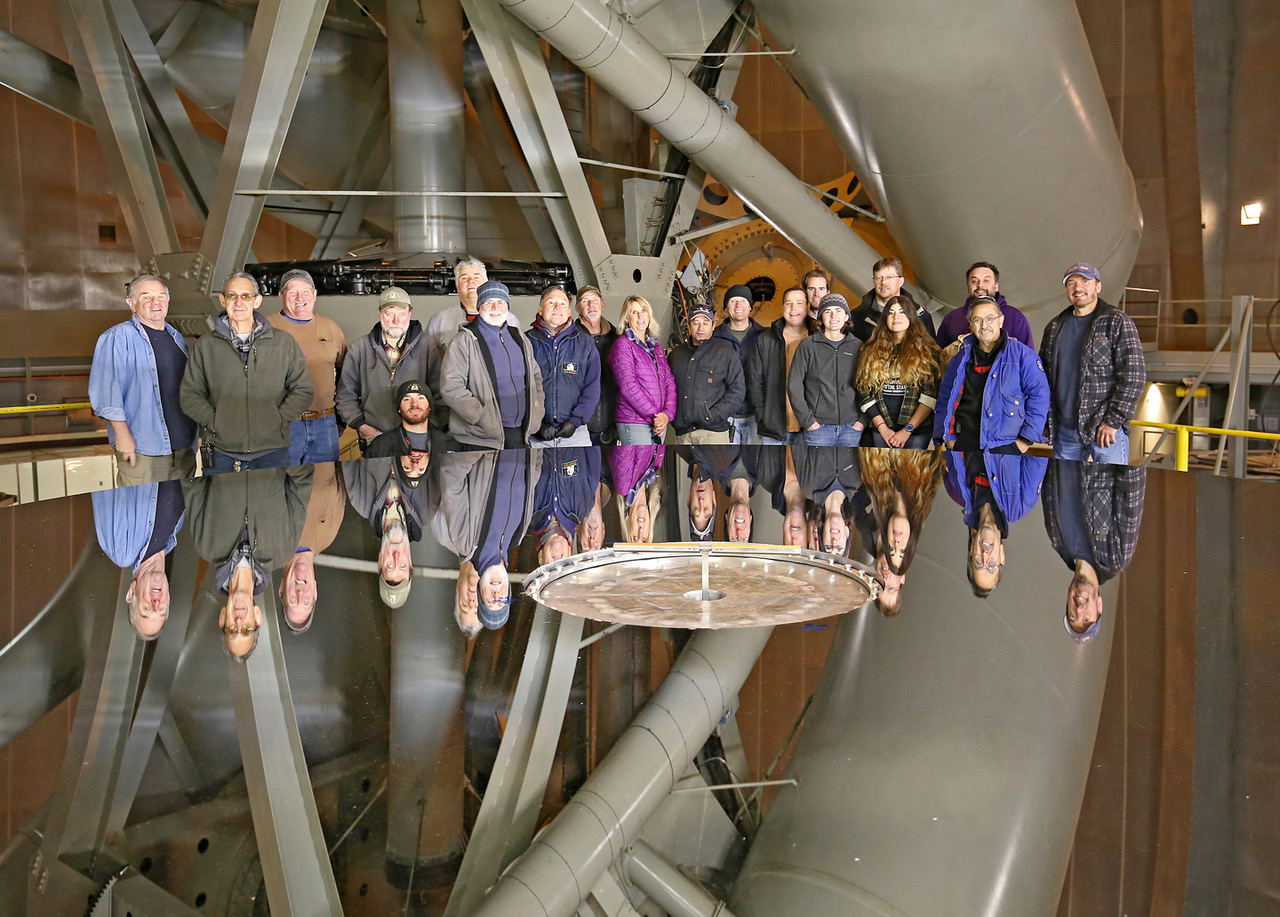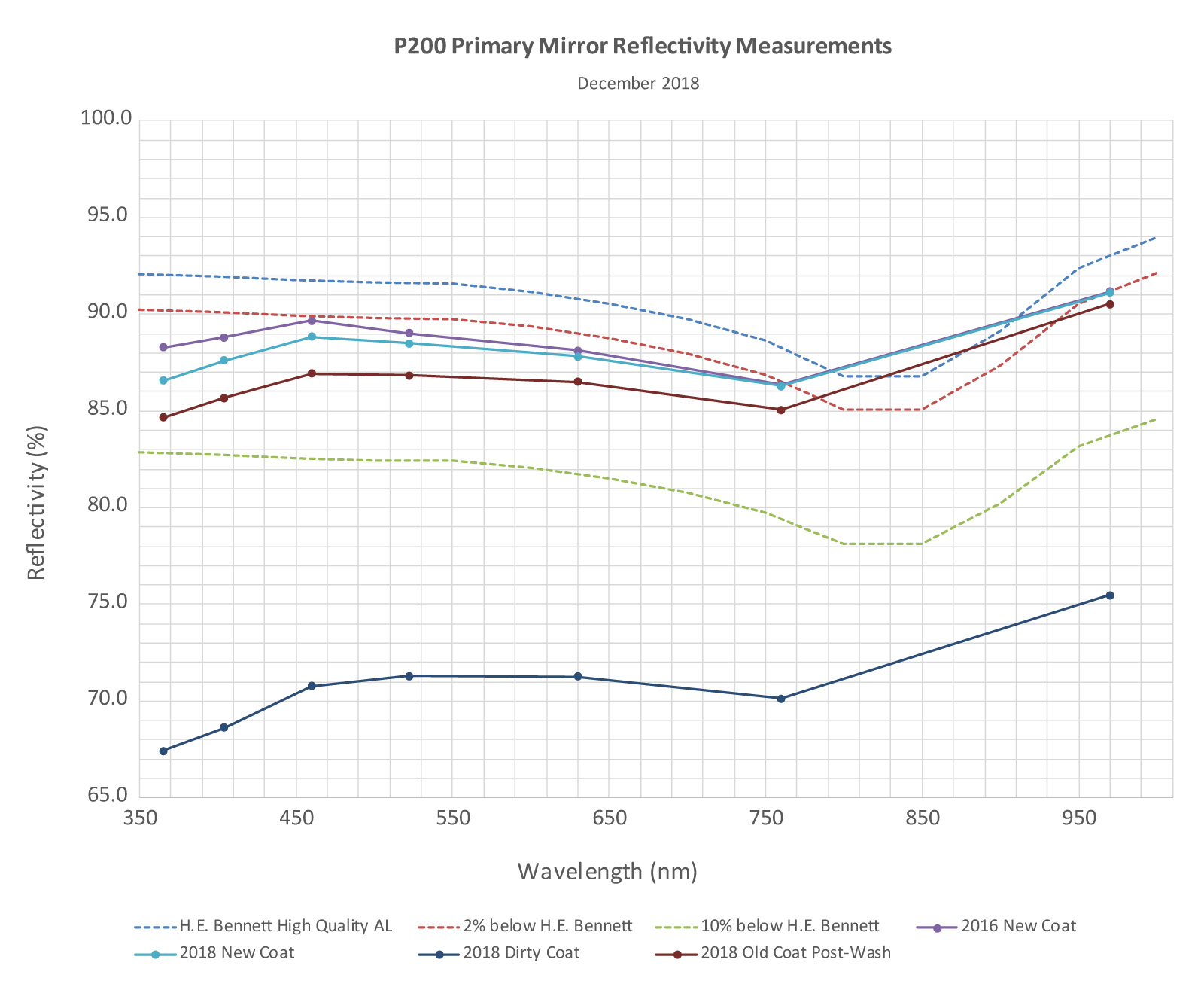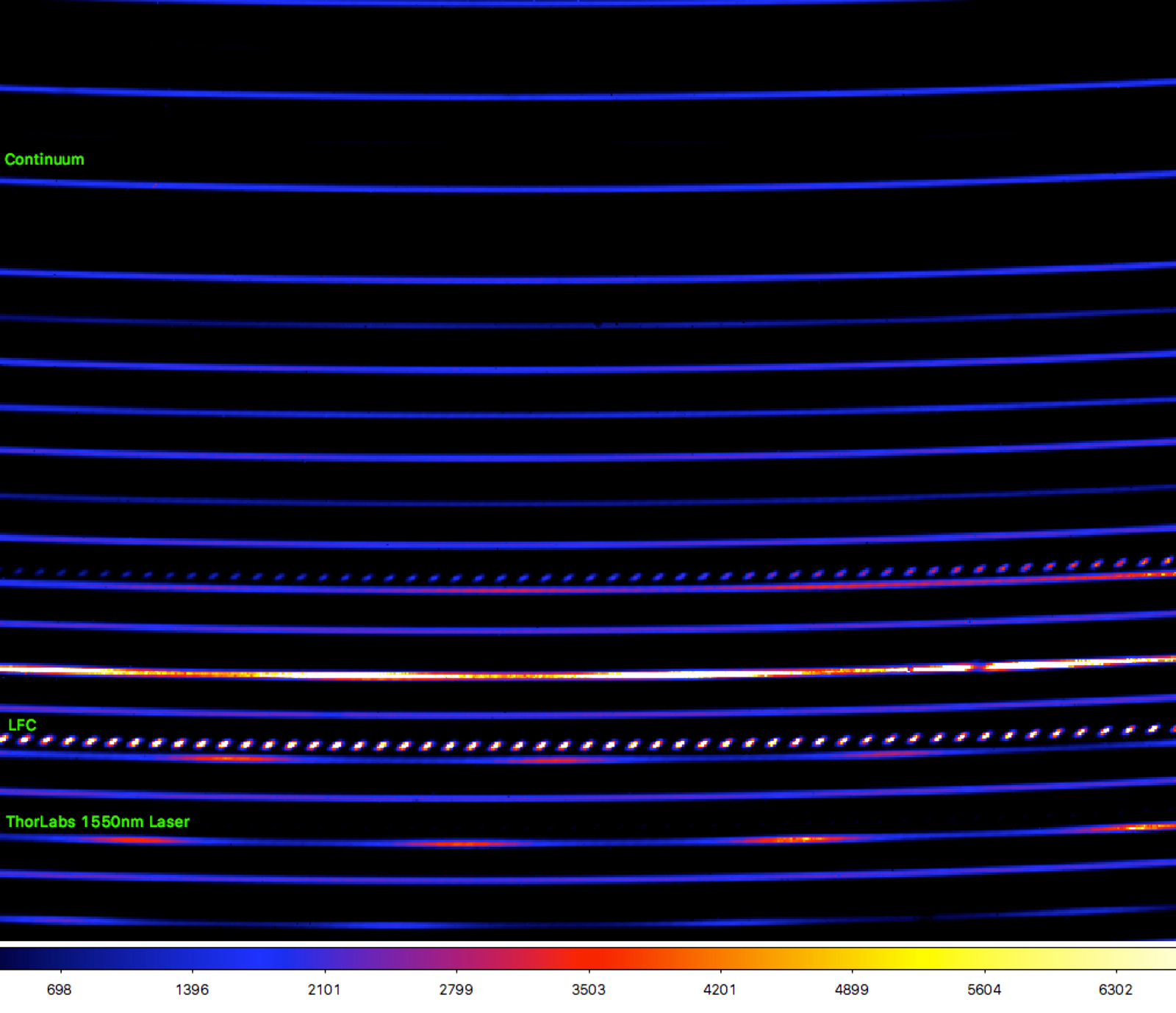In this issue

No. 2
Winter 2019
P200 Refurbishment and Return to Service
By Andy Boden and Rick Burruss
Very happy news: we have just completed our major fall engineering work and returned the telescope to service slightly ahead of schedule. P200’s first night back to science observations was Wednesday 12 December. But we’re getting ahead of ourselves…


Top: Palomar Summit Crew portrait with the newly recoated mirror, 03 December 2018. Bottom: Measured P200 primary reflectivity vs. wavelength following December 2018 recoating and comparison reflectivity measurements. (Palomar/Caltech)
Every seven or eight years we take the Hale Telescope out of service and remove the prime focus cage in order to service the structure, mechanisms, and optics—including re-aluminizing the secondary mirrors. You can think of this like routine car maintenance, if your car weighed 26 tons and you parked it 60 feet above your garage floor! As you might imagine, removing such an assembly and lowering it to the observing floor is approached with some care and planning. The summit team has been planning the refurbishment for months, and developed a carefully coordinated work plan to remove, refurbish, and replace the cage during November. Thanks to the dedication and professionalism of the staff the work went smoothly and as planned, and the cage was remounted on the telescope right on schedule—on 27 November.
Unsatisfied with just servicing the prime focus cage, the summit team also scheduled work to re-aluminize the Hale primary mirror during this engineering period. This is work that we typically do every two or three years; the primary was last recoated in 2016. The primary aluminizing went very well, and the summit team again did an outstanding job of handling, preparing, and recoating the mirror. The new coat is beautiful (see staff picture with the primary), and the measured reflectivity indicates that it will perform well in science observations (see reflectometry figure). We are excited to return P200 to service with newly recoated optics, and proud of our staff for their expert work in servicing the Hale Telescope in its milestone birthday year!
Science Highlight from Yale: Imaging of an Accreting Stellar-Mass Black Hole
By Charles Bailyn (Yale)
On Halloween night, a new bright galactic X-ray transient, denoted Swift 1858.6-0814, appeared in the sky. Within days, it had been observed by Swift, NICER, MAXI, and INTEGRAL, with further observations planned for other high energy observatories. On the night of November 2, C. Bailyn and G. Vasilopoulos (Yale) and Jennifer Milburn (Caltech) used the WASP instrument on the Hale 200-inch to identify the optical counterpart of this new source (see image below and ATel #12164). The large aperture of the 200-inch, together with the unusually short readout time for WASP region-of-interest observations, enabled the team to observe at a fairly high cadence (~3 times per minute) throughout the first hour of the night. Rapid time variability was observed, with the source brightening by a magnitude on a timescale of two minutes. Similar rapid time variability has also been observed in the X-ray data, as would be expected from jet emission associated with an accreting stellar-mass black hole. Monitoring of the source across the EM spectrum will continue as the outburst evolves.
Left: Discovery image of the optical counterpart of Swift 1858.6-0814. The X-ray source has been localized by Swift to 2”, and is coincident with the variable star inside the red circle. Right: Lightcurve of Swift 1858.6-0814 as observed with the Hale telescope and WASP on Nov 2 2018. Magnitudes are calibrated using PanStarrs photometry. Errors are estimated by differential photometry within the individual images. Note the rapid flare toward the end of the observing window. (C.Bailey/Yale)
JPL’s Instrumentation Program for the Palomar Hale Telescope
By Michael Werner (JPL)
JPL has always considered instrument development as a key element of its work at the Palomar Hale Telescope. This goes at least back to the early 1990’s, when Ressler and Werner used an array-based infrared camera, MIRLIN, at the Cass focus of the telescope. The success of MIRLIN, which later graduated to the Keck telescope, was in part responsible for JPL [and Ressler, as Project Scientist] being selected to develop the MIRI instrument for JWST.
A portion of the current JPL instrumentation work is funded as part of the MOU through which JPL gains access to the Hale Telescope. In the 2019 fiscal year, these funds add up to about $425K. We have committed $375K to an upgrade of the P3K system, the extreme adaptive optics system, which JPL has brought to life at Palomar over the past decade. P3K is heavily used now for validation of exoplanet candidates from Kepler, K2, and TESS. In addition, it will be heavily used in the coming years to feed the PARVI spectrograph described below, and it enables interesting one-off science programs such as Bonnie Buratti’s observations of Pluto at opposition.
P3K is undergoing a major revision stating in late July 2019. A new, improved wavefront sensor camera will be installed, and what is by now a rack of ten obsolete “buy them on eBay” computers and processors will be replaced with a single high performance modern computer. The results will be greatly improved reliability for the system as well as improved performance [higher strehl] for fainter targets. This work is being spearheaded by Seth Meeker at JPL. Details on the current performance of P3K are available on the Palomar observer’s page.
The remainder of the AO funds for 2019, about $50K, is being used by Tim Goodsall at JPL to adapt a filter wheel which had been part of the workhorse LFC camera for us with the new workhorse WaSP camera, which will provide a greatly improved visible wavelength imaging capability at the Hale Prime Focus. This will be final step in the replacement of LFC with WaSP, which is already well underway.
These two examples illustrate a reality of the JPL instrumentation work, which is that the scale of modern instrumentation in use at the 5m is such that even ~$425K/yr for several years is probably not enough to support the development of a new instrument from scratch. Increasingly, we expect our funding under the MOU to go towards upgrading existing instrumentation or as JPL’s contribution to an instrument being developed jointly with campus and other partners. In that spirit, much of our instrument funds for 2020 and beyond are earmarked for a contribution to the NGPS, the new spectrograph being spearheaded by Evan Kirby to replace the warhorse and workhorse DBSP. Even so, we would be very receptive to suggestions about small expenditures [say of order $50K or less] which might, for example, purchase a new filter or other optical component for one of the existing instruments in order to increase its scientific grasp.
In addition to funding through the Palomar MOU, instrumentation work at Palomar can be funded through other sources at JPL, increasing the value of our access to what is a unique instrumental and scientific test bed. As one example, in the early 2020’s we expect to use the Hale telescope as the ground terminal for the first demonstration of Deep Space [at the orbit of Mars] Optical Communication with Earth. The instrumentation for this experiment and its installation at the Coude focus of the Hale telescope, led by Abi Biswas will be evaluated during a series of engineering nights over the next few years. Similarly, JPL is supporting the development of the PARVI instrument described below, which reuses a good deal of hardware from the AMNH P1640 instrument and can thus be considered a major upgrade rather than a totally new initiative.
JPL Instrumentation Highlight: Palomar Radial Velocity Instrument (PARVI)
Gautam Vasisht (JPL)
The Palomar Radial Velocity Instrument (PARVI) will be the first ever adaptive optics fed, diffraction-limited spectrograph on sky, and is scheduled for commissioning at the Palomar Hale Telescope in June 2019. PARVI couples 1.2–1.8 µm light (J & H bands) into a single mode fiber and delivers it to a compact stabilized Echelle with a resolving power of 100,000. PARVI is housed in a small cryostat, about 300 times smaller in volume than those of seeing-limited instruments of similar resolving power on similarly sized telescopes. PARVI will be deployed along with a stable optical frequency comb wavelength ruler, spectrally broadened to cover the above-mentioned wavelength span. Besides carrying out the scientific program described below, PARVI will serve as a technology model for high resolving power spectrographs for space missions and extremely large telescopes. On the Hale Telescope, it will be used in conjunction with the P3K extreme adaptive optics system.

First PARVI Lab Data at Room Temperature: The image shows roughly a 1/14th of the 2d Echellogram, captured by a small format laboratory camera (640 × 512 pixels). The image is a composite, showing different sources illuminating the spectrograph around 1550 nm. (Smooth Blue) a thermal near infrared lamp, (Dotted) the PARVI 10 GHz mode-spaced optical frequency comb, (Red) the resolved modes of a lab 1550nm laser. First cryogenic tests with the H2RG detector will be in Feb 2019. (J.Fucik/D.Hover/COO)
PARVI will search for planets orbiting nearby low-mass stars, an important frontier in exoplanet science that requires detection of precision radial velocity signatures of 0.5–1.0 m s-1. These small stars afford important observational advantages that make it possible to detect small planets in the habitable zones of these hosts. Low-mass stars often have compact systems of at least two planets with periods less than 50 days, yet this population of stars is only beginning to be explored by Doppler surveys and much remains to be done. PARVI will both survey some of the closest mid to late M stars and observe transiting systems detected by TESS orbiting late type host stars. While TESS will survey the entire sky and detect transiting systems around relatively bright early- to mid-M stars, TESS’s continuous viewing zones at the ecliptic poles will have increased sensitivity to stars faint at visible wavelengths. Many of these stars will be mid to late M stars bright in the NIR for which small planets produce large transit signals. Adding a mass determination from RV measurements to the size and orbital characteristic data obtained from TESS transit measurements permits complete characterization of an exoplanet.
PARVI will also pursue planets orbiting young stars. K2 has identified a handful of transiting planets in young clusters and RV monitoring has revealed a few hot Jupiters orbiting T Tauri and post-T Tauri stars. Spectroscopic follow-up of youthful but fully formed planets identified by K2 and TESS would yield unique information on mass, radius and density that would help distinguish between hot and cold start formation models.
Above is a first laboratory light image showing the PARVI focal plane at full resolving power (along with frequency comb spots illuminating a few orders).
Data Reduction Tips and Resources
By Lin Yan
New users of our most popular P200 instruments can find below a list of helpful tips and resources for data reduction.
First of all, a for-purpose P200 data reduction slack channel (sign-up here) was set up to provide quick information exchange online. Generally experienced users of each instrument from various institutions are the most useful sources of information. Please feel free to ask questions on slack channel.
Below we list some of the resources and software for both the public and semi-private instruments on P200.
- DBSP: Several different reduction tools were developed by various groups from China, Yale, and Caltech. The Caltech software is a python script which wraps Pyraf commands together into a single command line within python. This tool was written by Eric Bellm (now at U. of Washington), and is available here. If you use this tool, please cite the ASCL entry: 2016ascl.soft02002B for this work. To improve the spectral flatfielding, the revised version of the software were developed at Caltech. Please contact Lin Yan for information (lyan at caltech.edu).
- TripleSpec: The widely used software, Spextool, was written in IDL by Mike Cushing from University of Toledo. This tool is available together with an extensive documentation at Astrophysics Source Code Library. Many users from Yale University, IPAC and Caltech are familiar with the instrument and data reduction software. In addition, Tom Barlow from Caltech has written a software called TSX: TripleSpec eXtraction, available at this website. The detailed description of the software, the installation instruction and the reduction steps are also provided.
- PCWI: The Cosmic Web Imaginger team has produced the pipeline written in IDL, available here.
- CHIMERA: A lot of information on this instrument can be found on the instrument website. The data reduction software is provided by the team, and available at github.
- WASP: This is a wide field optical direct imaging camera. The basic reduction can be done using Pyraf. Documentation on Pyraf can be found here. Jennifer Milburn at Caltech has developed a set of software tools for this instrument. She also keeps an extensive calibration data archive. Please contact Jennifer Milburn at jwm at astro.caltech.edu.
- WIRC: This is a wide field infrared imaging camera. Many different pipelines for processing infrared direct images are available online. SNAP is one example. Several private software tools are used by observers at Caltech and IPAC/JPL. Please contact people who have used WIRC for suggestions.
NAOC Observer FAQ
By Lin Yan and Sophia Dai
There are new subsections in the FAQ and Observer Travel Page specific to the needs of NAOC-designated observers.
1. How to apply for P200 telescope time in China?
The Telescope Access Program (TAP) gives all Chinese astronomers access to international ground-based facilities, including Palomar 200-inch telescope. Everyone who is planning a P200 proposal should check with the TAP website for call for proposals for specific details, including deadlines, proposal requirements, submission, evaluation and announcement process.
2. How to apply for visa if your proposal gets approved and scheduled?
NAOC TAP coordinators will contact NAOC-approved project Principal Investigators (PIs) for the necessary information to support visa application paperwork. An official invitation letter to support visa application in China will be prepared at Caltech and distributed by the TAP coordinator to observers who are designated by NAOC to represent approved projects at Palomar Observatory.
3. Which airport in Los Angeles to use when flying from cities in China?
The Los Angeles and San Diego areas have several airports. The largest one is Los Angeles International Airport (LAX). There are many direct, daily flights from Beijing, Shanghai, Chengdu, Qingdao and other cities in China to LAX. This is the easiest and quickest way.
4. How to travel to the Palomar telescope site?
From the Los Angeles International Airport, the most common way for observers to commute to the Palomar Observatory is by driving. One option is to rent a car from the airport. It will take about 3 – 3.5 hours driving on free-ways and twisty mountain roads. It is important to note that night time and bad weather can make this driving very challenging and dangerous. Detailed directions and instructions on how to drive to the observatory can be found on the driving directions page. An alternative option is to call a taxi or shared commute service, such as Uber and Lyft. The price varies between companies, on the order of $200 or a bit more.
Questions? We've answered many common visiting, media, and academic questions in our public FAQ page.
Please share your feedback on this page at the
COO Feedback portal.
Palomar Observer 2
Last updated: 15 January 2019 LY/AFB/ACM

